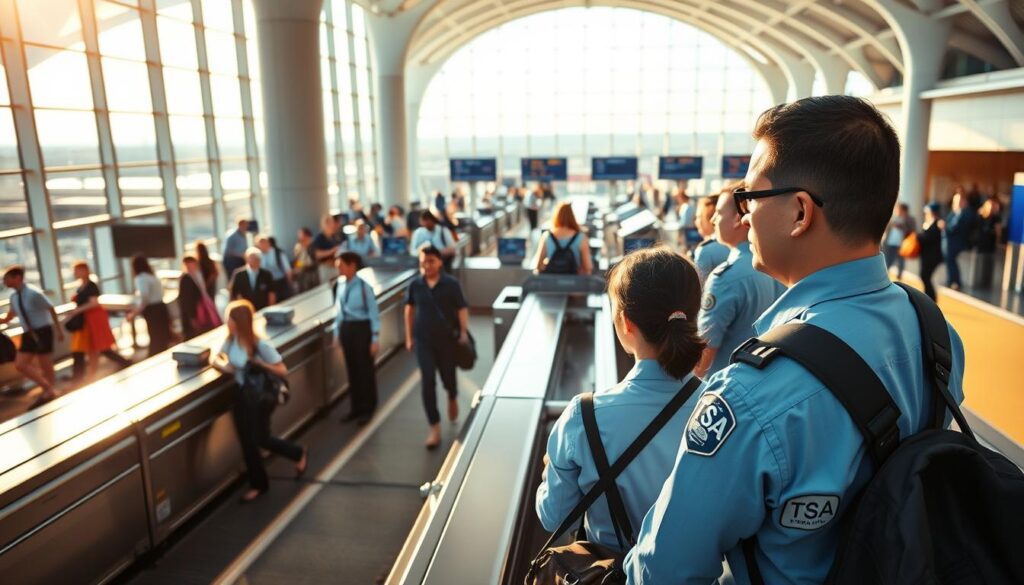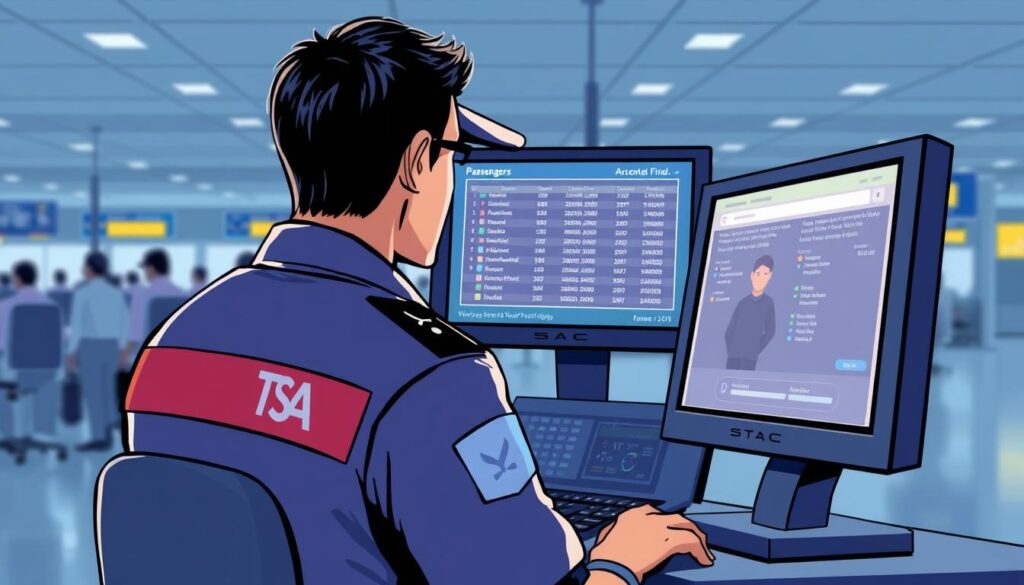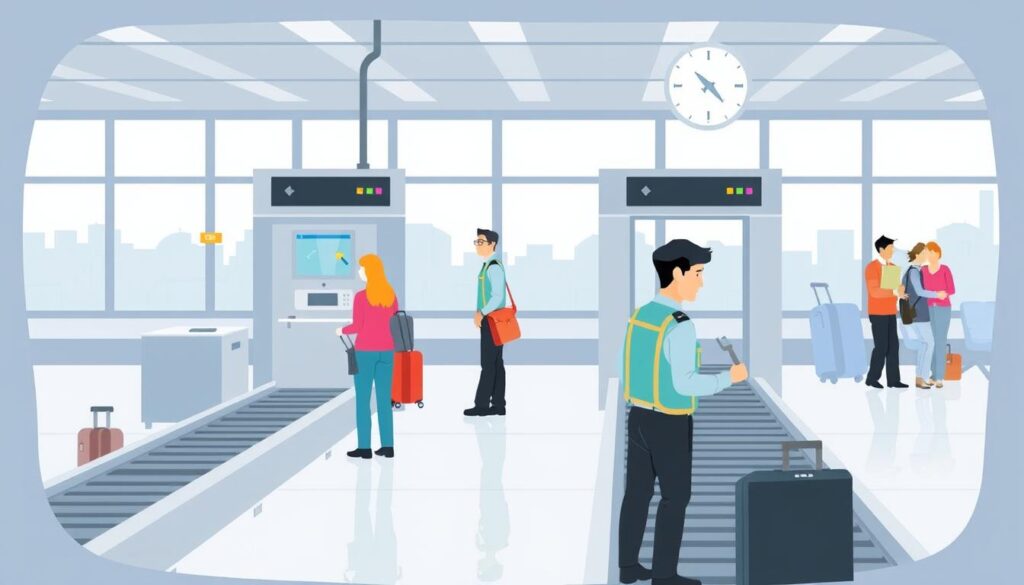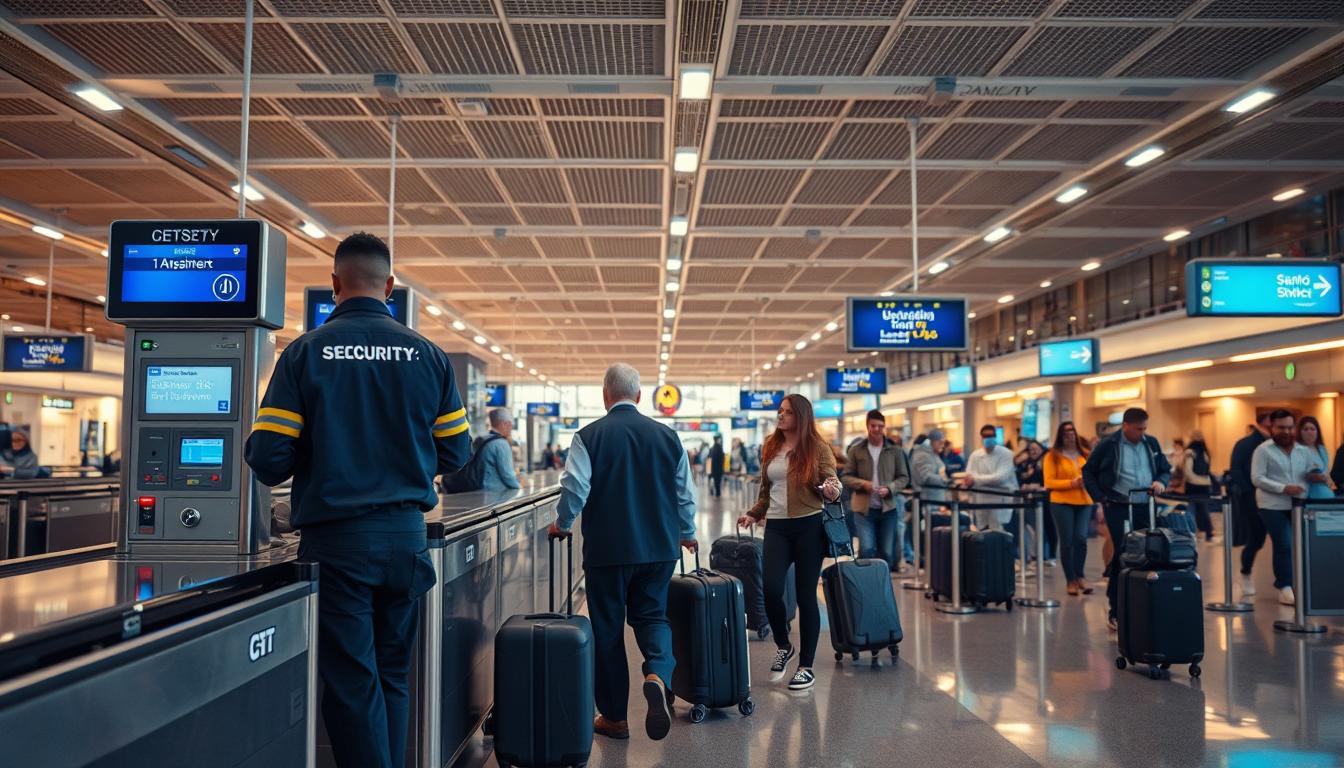Following the events of 9/11, the United States saw a significant overhaul in its approach to aviation security. The establishment of the Transportation Security Administration marked a pivotal moment in the nation’s efforts to safeguard its air travel infrastructure.
The TSA has since implemented various security initiatives to ensure the safety of millions of passengers. Through programs like the Secure Flight Program, the TSA works closely with industry stakeholders to strengthen the overall security framework of the nation’s aviation system.
Key Takeaways
- Understanding the TSA’s role in protecting the nation’s air transportation infrastructure.
- Exploring the evolution of the TSA since its establishment.
- Discovering the various security initiatives implemented by the TSA.
- Learning about specific programs like the Secure Flight Program.
- The TSA’s collaborative approach with industry stakeholders.
The Evolution of Aviation Security in the United States
The events of September 11, 2001, marked a pivotal moment in the history of aviation security in the United States. The devastating terrorist attacks on that day exposed significant vulnerabilities in the existing aviation security measures, prompting a comprehensive overhaul of the system.
The aftermath of 9/11 saw an immediate response from the U.S. government to address the security gaps that had been exploited. This response culminated in the enactment of the Aviation and Transportation Security Act (ATSA) on November 16, 2001. The ATSA was a landmark legislation that not only created the Transportation Security Administration (TSA) but also fundamentally transformed the way aviation security was managed in the United States.
The Birth of TSA: Aviation and Transportation Security Act of 2001
The Aviation and Transportation Security Act of 2001 was a direct response to the security failures highlighted by the 9/11 attacks. By creating the TSA, the Act aimed to standardize and improve aviation security across the United States. Section 132(a) of the ATSA mandated the Under Secretary of Transportation for Security to implement a security program for charter air carriers with a maximum certificated takeoff weight of 12,500 pounds or more. This provision underscored the comprehensive nature of the security reforms introduced by the Act.
The establishment of the TSA represented a significant shift in the U.S. government’s approach to transportation security. For the first time, a dedicated agency was tasked with overseeing and implementing security measures across various modes of transportation, with a particular focus on aviation. This marked a departure from the previous arrangement, where aviation security was primarily the responsibility of the Federal Aviation Administration (FAA).
From FAA to TSA: Transition of Aviation Security Functions
The transition of aviation security functions from the FAA to the TSA was a complex process that required significant coordination and resources. The TSA had to rapidly build its workforce and capabilities to assume responsibility for security at airports nationwide within its first year of existence. This involved not only transferring personnel and resources but also developing new security protocols and procedures.
During this transition period, the aviation industry faced numerous challenges as it adapted to new security requirements and protocols. The TSA worked closely with various stakeholders, including airlines, airports, and other government agencies, to implement the new security measures effectively. The successful transition marked a new era in aviation security, with the TSA at the forefront of efforts to protect the nation’s transportation systems.
As the TSA continued to evolve and mature, it implemented more sophisticated and layered security approaches. These measures were designed to address emerging threats and improve the overall efficiency of the security process. The creation of the TSA and the transfer of aviation security functions from the FAA to the TSA represented a fundamental shift in how the United States government approached transportation security as a matter of national security.
Understanding the Transportation Security Administration’s Mission

The TSA’s primary objective is to secure the nation’s transportation systems, balancing security needs with the requirement for efficient travel and commerce. This involves a complex interplay of various security measures and protocols designed to protect the traveling public and the transportation infrastructure.
As the TSA assumed responsibility for security at the nation’s airports and deployed a federal workforce to screen all commercial airline passengers and baggage, it marked a significant shift in aviation security. The Aviation and Transportation Security Act of mandated this change, underscoring the importance of robust security protocols in the aviation sector.
Protecting the Nation’s Transportation Systems
Protecting the nation’s transportation systems is a multifaceted challenge that requires a risk-based approach to security. The TSA allocates resources based on the most significant threats to transportation infrastructure, ensuring that security measures are both effective and efficient. This approach allows the TSA to adapt to evolving threats and to prioritize its efforts where they are most needed.
The TSA’s mission encompasses not only the security of passengers and baggage but also the protection of the broader transportation network. This includes collaborating with various stakeholders, such as airlines, airport authorities, and other government agencies, to create a comprehensive security framework.
Key Stakeholders and Partners in Aviation Security
The TSA works closely with a range of stakeholders and partners to enhance aviation security. These include airlines, airport authorities, aircraft manufacturers, and other government agencies. By fostering a collaborative ecosystem, the TSA can leverage the expertise and resources of its partners to improve security outcomes.
International partnerships also play a crucial role in strengthening global aviation security standards. The United States works closely with foreign counterparts to share best practices and coordinate efforts to address common security challenges. This cooperation is essential in ensuring that security measures are consistent and effective across different jurisdictions.
The role of private sector stakeholders is equally important, as they implement security measures and develop innovative security technologies. The TSA coordinates with these stakeholders to ensure that security protocols are robust and effective, and that new technologies are integrated into the security framework.
Overview of TSA Aviation Programs

The Transportation Security Administration (TSA) has developed a multifaceted approach to aviation security, encompassing a wide range of programs designed to protect the nation’s transportation systems. These initiatives are crucial in ensuring the safety of passengers, crew members, and aircraft.
The TSA’s aviation security efforts are focused on multiple layers of security, including passenger screening, cargo security, and aircraft operator security programs. By implementing these diverse initiatives, the TSA aims to stay ahead of evolving threats and maintain the highest security standards.
Passenger Screening Initiatives
The TSA has made significant advancements in passenger screening, transitioning from traditional metal detectors to advanced imaging technology and behavior detection techniques. The Secure Flight program is a critical component of this effort, ensuring that 100% of passengers are screened before boarding their flights.
Through the use of cutting-edge technology and risk-based screening approaches, the TSA is able to efficiently process passengers while maintaining high security standards. This approach allows for a more streamlined security process, reducing wait times and enhancing the overall travel experience.
Cargo Security Programs
The TSA’s cargo security programs are designed to ensure that items transported on passenger and cargo aircraft undergo appropriate screening. With the goal of screening 100% of cargo, the TSA is continually working to enhance its cargo security initiatives, leveraging the latest technology to stay ahead of emerging threats.
By implementing robust cargo security measures, the TSA is able to mitigate potential risks and prevent unauthorized items from being transported on aircraft.
Aircraft Operator Security Programs
The TSA works closely with aircraft operators to implement tailored security programs based on aircraft size, operations type, and risk profile. These programs are designed to provide an additional layer of security, ensuring that aircraft operators are equipped to handle potential security threats.
By collaborating with aircraft operators, the TSA is able to create a more comprehensive security framework, enhancing the overall safety of the aviation system.
In conclusion, the TSA’s aviation programs are a critical component of the nation’s aviation security framework. By implementing a range of initiatives, including passenger screening, cargo security, and aircraft operator security programs, the TSA is able to maintain a high level of security while facilitating the efficient movement of people and goods.
The Secure Flight Program

By leveraging the Secure Flight Program, the TSA is able to screen 100 percent of all passengers traveling into, out of, and within the United States. This program is a critical component of the TSA’s efforts to ensure the security of air travel.
The Secure Flight Program is designed to enhance the security of air travel by comparing passenger information against government watchlists. This process helps to identify potential security risks before passengers arrive at the airport.
How Secure Flight Works
The Secure Flight Program works by matching passenger information against various government watchlists. Airlines collect specific information from passengers, including their name, date of birth, and government-issued ID number, which is then transmitted to the TSA for screening.
This information is used to identify passengers who may pose a security risk. The TSA uses sophisticated algorithms to compare the passenger information against the watchlists, helping to prevent individuals on these lists from boarding flights.
Key aspects of the Secure Flight Program include:
- Matching passenger information against government watchlists
- Identifying high-risk passengers while facilitating travel for those who pose minimal risk
- Streamlining the check-in process and reducing instances of misidentification at security checkpoints
Benefits for Passengers and Airlines
The Secure Flight Program provides several benefits for both passengers and airlines. For passengers, it helps to ensure a smoother travel experience by reducing the likelihood of misidentification at security checkpoints.
For airlines, the program enhances security while also improving operational efficiency. By identifying potential security risks early, airlines can reduce the number of passengers who are delayed or denied boarding due to security concerns.
The program has evolved over time to incorporate additional risk-based security measures, further enhancing the security of air travel.
The TSA has implemented robust privacy protections to safeguard passenger information. These measures ensure that sensitive information is handled and stored securely, protecting passengers’ personal data.
Twelve-Five Standard Security Program (TFSSP)

The Transportation Security Administration (TSA) introduced the Twelve-Five Standard Security Program to enhance aviation security. This program is designed for aircraft operators using aircraft with a maximum certificated takeoff weight of more than 12,500 pounds. The TFSSP outlines specific security measures and requirements to ensure the safety of passengers, crew, and aircraft.
The TFSSP was established following a final rule published in the Federal Register on February 22, 2002. This rule required certain aircraft operators to implement security measures, including criminal history records checks on flightcrew members and restricting access to the flight deck. Initially, the rule applied to aircraft with a maximum certificated takeoff weight of 12,500 pounds or more. However, in June 2004, the TSA released a technical change that limited the TFSSP’s applicability to aircraft weighing more than 12,500 pounds.
Eligibility Requirements for Aircraft Operators
To be eligible for the TFSSP, aircraft operators must conduct scheduled or charter operations, carrying passengers or cargo, to, from, within, or outside the United States. The program specifically applies to operations using aircraft with a maximum certificated takeoff weight of more than 12,500 pounds. Operators must comply with the security measures outlined in the TFSSP to ensure the safety and security of their operations.
Security Measures and Requirements
The TFSSP mandates several security measures, including crew vetting through criminal history record checks and restricting access to the flight deck. Aircraft operators must implement these measures to prevent unauthorized access and ensure the security of the aircraft. Additionally, operators are required to adhere to specific security protocols for passenger and cargo screening.
Application Process for TFSSP
Aircraft operators must follow a specific application process to participate in the TFSSP. This involves submitting required information to the TSA and demonstrating compliance with the program’s security measures. Operators should prepare all necessary documentation before contacting the TSA to initiate the application process.
Working with TSA Principal Security Specialists
TSA Principal Security Specialists (PSS) play a crucial role in implementing and overseeing the TFSSP for individual operators. They work closely with aircraft operators to ensure compliance with the program’s requirements and provide guidance on security measures. Operators must collaborate with their assigned PSS to successfully implement the TFSSP.
Requesting and Implementing the TFSSP

To ensure compliance with TSA regulations, aircraft operators must understand the process of requesting and implementing the Twelve-Five Standard Security Program (TFSSP). This program is crucial for operators of charter aircraft with a maximum certificated takeoff weight of more than 12,500 pounds.
The first step in implementing the TFSSP is to contact your TSA Principal Security Specialist (PSS) for your home base of operations. You can reach out to them via phone or email, and if emailing, make sure to include “TFSSP Request” in the subject line. When making the request, be prepared to provide specific information about your operation.
Step-by-Step Application Process
The application process involves several key steps. First, you need to provide your company name (including any DBA) and four-letter designator, the name, title, and phone numbers of your security contact person, your FAX number and email address, and the name and work phone number of your Principal Operations Inspector (POI).
Required Documentation
Having the necessary documentation ready is crucial. This includes your company details and contact information for your security personnel. Ensuring that this information is accurate and readily available will streamline the verification process.
Non-Disclosure Agreements
After your information is verified by the TSA PSS through your POI, you will be sent a blank non-disclosure agreement along with a copy of 49 CFR 1520. This regulation governs the handling and protection of sensitive security information. You must read the regulation, sign the non-disclosure form, and return it to the TSA.
Accessing the TFSSP Materials
Once the TSA receives your signed non-disclosure agreement, you will be provided with a username and password along with instructions on how to download the TFSSP from the TSA’s website. This secure online portal is where you will access all the necessary security procedures and training materials.
To facilitate a smooth application process, it’s essential to understand the requirements for implementing the TFSSP. This includes not only the initial application but also the ongoing compliance and training requirements.
By following these steps and understanding the process and requirements, you can successfully request and implement the TFSSP for your aircraft operations. This not only ensures compliance with TSA regulations but also enhances the security of your operations.
TSA Guidelines for Contractors and Vendors

When it comes to aviation security, the TSA provides clear directives for aircraft operators on utilizing contractors and vendors for training development and delivery. As an aircraft operator, you must understand and comply with these guidelines to ensure the security and integrity of your security training programs.
The TSA allows aircraft operators to use contractors and vendors for security training, but with specific conditions. Understanding these conditions is crucial for maintaining compliance and ensuring that your security training programs meet the required standards.
Conditions for Using Contractors in Training
The TSA has established four key conditions for aircraft operators who wish to use contractors for security training. Firstly, it is your responsibility to ensure that the training provided by contractors meets the minimum TFSSP requirements as outlined by the TSA. This means you must verify that the training content is compliant with TSA regulations.
Secondly, you are required to limit the sensitive security information (SSI) shared with contractors to only what is necessary for them to develop or conduct the training. You must not provide contractors with the entire TFSSP or access to the ACO500 webboard.
Sensitive Security Information (SSI) Handling
Handling SSI is a critical aspect of working with contractors. You are fully responsible for all SSI released to contractors and vendors. It is essential to provide SSI on a need-to-know basis only, ensuring that contractors understand the sensitivity of the information they are handling.
To comply with TSA regulations, you must ensure that contractors and their employees who have access to SSI understand the protocols for handling this sensitive information. This includes ensuring they sign a non-disclosure agreement before accessing any SSI.
Contractor Vetting and Compliance
Vetting contractors and ensuring their compliance with TSA requirements is another critical responsibility. You must verify the identity of contractor employees involved in training development or delivery and check their names against the current No-Fly list.
Moreover, you are required to maintain proper documentation of contractor compliance. This not only helps in ensuring that your security training programs are compliant with TSA regulations but also facilitates smooth TSA inspections.
By following these guidelines and maintaining a vigilant approach to security, you can effectively manage contractor relationships while upholding the highest standards of aviation security.
Baggage and Cargo Screening Programs

The TSA’s efforts to enhance aviation security have led to the development of sophisticated baggage and cargo screening programs, leveraging cutting-edge technology to detect potential threats. These programs are crucial in ensuring the safety of air travel, protecting both passengers and aircraft from potential dangers.
The TSA’s baggage screening process is designed to be comprehensive, utilizing multiple layers of security to identify and mitigate threats. This approach involves the use of advanced technology, including explosive detection systems and advanced imaging technology, to screen baggage and cargo effectively.
100% Screening Initiative
The 100% Screening Initiative is a landmark program aimed at screening all baggage and cargo transported on passenger aircraft. This initiative was driven by legislative mandates and has been implemented in phases, with the TSA working closely with airports and airlines to achieve the goal of 100% screening.
The initiative has transformed security protocols for both passenger baggage and air cargo, significantly enhancing the overall security posture of the aviation industry. By screening 100% of baggage and cargo, the TSA ensures that potential threats are identified and neutralized before they can pose a risk.
Technology and Systems Used in Screening
The TSA employs a range of technologies to screen baggage and cargo, including explosive detection systems (EDS), advanced imaging technology (AIT), and trace detection equipment. These technologies are designed to detect a wide range of potential threats, from explosives to other dangerous items.
The use of multiple screening technologies creates multiple layers of security, making it increasingly difficult for threats to go undetected. The TSA continually updates and improves its screening technologies to stay ahead of emerging threats and to maintain the highest level of security.
Flight Deck Security Measures

The TSA has introduced stringent security protocols for flight decks to prevent unauthorized access and enhance overall aviation security. These measures are multi-layered and designed to protect the flight deck from various potential threats.
Access Restrictions and Controls
One of the critical aspects of flight deck security is controlling access to the cockpit. After 9/11, there was a significant hardening of cockpit doors to prevent unauthorized entry. These doors are now designed to be highly secure, with features such as reinforced materials and advanced locking systems.
Access to the flight deck is strictly regulated, with protocols in place to ensure that only authorized personnel can enter. This includes the use of keycards, biometric identification, and other access control measures.
Criminal history record checks are also conducted on flight crew members to further enhance security. These checks help to identify potential security risks and prevent individuals with malicious intent from accessing the flight deck.
Security Training for Flight Crew
Security training is a vital component of flight deck security. Flight crew members receive specialized training to prepare them for potential security threats and to teach them how to respond effectively in emergency situations.
This training includes procedures for handling unauthorized access attempts, dealing with hostile individuals, and maintaining communication between the cabin and flight deck crew. By equipping flight crew members with the necessary skills and knowledge, the TSA aims to enhance the overall security of the flight deck.
Effective communication between pilots, flight attendants, and ground security personnel is also crucial in maintaining flight deck security throughout all phases of flight. This coordination ensures a unified response to any security incidents that may arise.
Compliance and Enforcement
Ensuring compliance with aviation security regulations is a critical aspect of the Transportation Security Administration’s (TSA) mission to protect the United States’ transportation systems. The TSA achieves this through a comprehensive compliance and enforcement framework that involves regular inspections, strict requirements, and consequences for non-compliance.
TSA Inspection Process
The TSA conducts inspections at airports and aircraft operations facilities nationwide to ensure compliance with security regulations. These inspections are carried out by TSA Principal Security Inspectors (PSIs) who oversee compliance with security programs like the Twelve-Five Standard Security Program (TFSSP). The inspection process involves reviewing documentation, observing security procedures, and assessing the overall security posture of the operator.
Types of Inspections: The TSA conducts various types of inspections, including scheduled comprehensive reviews and unannounced spot checks. This ensures that operators maintain continuous compliance with security requirements.
Documentation Requirements: Operators must maintain detailed records to demonstrate ongoing compliance with security regulations. This includes documentation of security procedures, training records, and incident reports.
Consequences of Non-Compliance
Failure to comply with TSA security requirements can result in significant consequences, including civil penalties, operational restrictions, and certificate actions. The TSA takes a risk-based approach to enforcement, focusing on the most critical security vulnerabilities.
Remediation Process: Operators who are found to be non-compliant must address the identified issues through a remediation process. This involves implementing corrective actions and demonstrating compliance to the TSA.
Appeals Process: Operators who believe that enforcement actions have been incorrectly applied can appeal through a formal process. This ensures that operators have a fair opportunity to dispute any findings and resolve disputes.
By maintaining a robust compliance and enforcement framework, the TSA ensures the security of the nation’s aviation system. Operators must remain vigilant in their compliance efforts to avoid the consequences of non-compliance and contribute to the overall security of the transportation network.
Future Directions in Aviation Security
The future of aviation security is being shaped by emerging threats, technological advancements, and the TSA’s proactive strategies. As you look to the horizon, it’s clear that the landscape of aviation security is evolving rapidly.
The TSA is continually assessing and addressing new challenges to ensure the security of the United States’ transportation systems. You can expect a multifaceted approach that includes enhanced technology, improved training for security personnel, and more effective collaboration with international partners.
Emerging Threats and Challenges
Aviation security faces a myriad of evolving threats, from cyberattacks on transportation infrastructure to the potential for new forms of terrorism. The TSA must stay vigilant, adapting its security protocols to counter these threats effectively. You will see a focus on intelligence gathering and risk assessment to preempt potential security breaches.
- Cyber threats to aviation infrastructure
- Evolving terrorist tactics and strategies
- The need for enhanced international cooperation
Technological Innovations in Security
Technology is playing a crucial role in enhancing aviation security. You will witness significant advancements in areas such as biometric identification, artificial intelligence (AI)-based screening systems, and advanced imaging technologies. These innovations not only improve security but also aim to streamline the passenger experience.
The TSA is working closely with industry partners and leveraging its innovation task force to develop and deploy next-generation security solutions. By embracing technologies like AI and biometrics, the TSA is enhancing its ability to detect and prevent security threats while reducing the burden on passengers and airlines.
As the aviation security landscape continues to evolve, you can expect the TSA to remain at the forefront of innovation and security. By balancing the need for robust security measures with the goal of operational efficiency, the TSA is shaping a safer and more secure future for air travel.
Conclusion
As we reflect on the comprehensive overview of theTransportation Security Administration’saviation security programs, it’s clear that the TSA plays a vital role in safeguarding the nation’stransportationsystems.
The evolution ofaviation securityin theUnited Stateshas been significant, transforming from a relatively less secure environment to a highly sophisticated, multi-layered security framework. Programs likeSecure Flightand theTwelve-Five Standard Security Programwork in tandem to ensure the safety of air travel.
You’ll appreciate the collaborative nature ofaviation security, which involves government agencies, airlines, airports, and other stakeholders working together toenhance security. This partnership is crucial in addressing emerging threats and leveraging new technologies to stay ahead of potential risks.
TheTransportation Security Administrationcontinues to balance robustsecuritymeasures with the need to facilitate the free movement of people and commerce. As theSecretary of Transportation Securitylooks to the future, it’s evident that the TSA remains committed to adapting its strategies to meet new challenges.
In conclusion, the TSA’s efforts have significantly improvedaviation securityin theUnited Statessince 2001. As you consider the complex systems in place, you’ll gain a deeper appreciation for the dedicated professionals working behind the scenes to ensure safe air travel.
